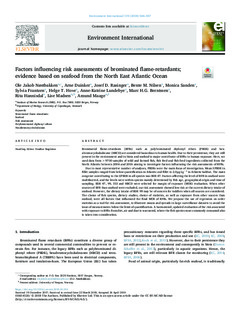| dc.contributor.author | Nøstbakken, Ole Jakob | |
| dc.contributor.author | Duinker, Arne | |
| dc.contributor.author | Rasinger, Josef Daniel | |
| dc.contributor.author | Nilsen, Bente Merete | |
| dc.contributor.author | Sanden, Monica | |
| dc.contributor.author | Frantzen, Sylvia | |
| dc.contributor.author | Hove, Helge Torbjørn | |
| dc.contributor.author | Lundebye, Anne-Katrine | |
| dc.contributor.author | Berntssen, Marc | |
| dc.contributor.author | Hannisdal, Rita | |
| dc.contributor.author | Madsen, Lise | |
| dc.contributor.author | Måge, Amund | |
| dc.date.accessioned | 2018-09-10T09:18:27Z | |
| dc.date.available | 2018-09-10T09:18:27Z | |
| dc.date.created | 2018-08-31T15:54:25Z | |
| dc.date.issued | 2018 | |
| dc.identifier.citation | Environment International. 2018, 119 544-557. | nb_NO |
| dc.identifier.issn | 0160-4120 | |
| dc.identifier.uri | http://hdl.handle.net/11250/2561682 | |
| dc.description.abstract | Brominated flame-retardants (BFRs) such as polybrominated diphenyl ethers (PBDE) and hexabromocyclododecane (HBCD) are considered hazardous to human health. Due to their persistence, they are still present in the environment and in biota and seafood is major contributor of BFRs to human exposure. Here, we used data from >9700 samples of wild and farmed fish, fish feed and fish feed ingredients collected from the North Atlantic between 2006 and 2016 aiming to investigate factors influencing the risk assessments of BFRs.
Due to most representative number of analyses, PBDEs were the main focus of investigation. Mean ∑PBDE in fillet samples ranged from below quantification in Atlantic cod fillet to 2.0 μg kg−1 in Atlantic halibut. The main congener contributing to the ∑PBDE in all species was BDE 47. Factors affecting the level of BFR in seafood were multifaceted, and the levels were within species mainly determined by fish age, geographical origin and time of sampling. BDE 47, 99, 153 and HBCD were selected for margin of exposure (MOE) evaluation. When other sources of BFR than seafood were excluded, our risk assessment showed low risk at the current dietary intake of seafood. However, the dietary intake of BDE 99 may be of concern for toddlers when all sources are considered. The choice of fish species, dietary studies, choice of statistics, as well as exposure from other sources than seafood, were all factors that influenced the final MOE of BFRs. We propose the use of regression on order statistics as a tool for risk assessment, to illustrate means and spreads in large surveillance datasets to avoid the issue of measurements below the limit of quantification. A harmonized, updated evaluation of the risk associated with exposure to BFRs from diet, air and dust is warranted, where the fish species most commonly consumed also is taken into consideration. | nb_NO |
| dc.language.iso | eng | nb_NO |
| dc.title | Factors influencing risk assessments of brominated flame-retardants; evidence based on seafood from the North East Atlantic Ocean | nb_NO |
| dc.title.alternative | Factors influencing risk assessments of brominated flame-retardants; evidence based on seafood from the North East Atlantic Ocean | nb_NO |
| dc.type | Journal article | nb_NO |
| dc.type | Peer reviewed | nb_NO |
| dc.description.version | publishedVersion | nb_NO |
| dc.source.pagenumber | 544-557 | nb_NO |
| dc.source.volume | 119 | nb_NO |
| dc.source.journal | Environment International | nb_NO |
| dc.identifier.doi | 10.1016/j.envint.2018.04.044 | |
| dc.identifier.cristin | 1605937 | |
| dc.relation.project | Fiskeri- og havbruksnæringens forskningsfond: 900112 | nb_NO |
| dc.relation.project | Fiskeri- og havbruksnæringens forskningsfond: 232104 | nb_NO |
| dc.relation.project | Fiskeri- og havbruksnæringens forskningsfond: 232094 | nb_NO |
| cristin.unitcode | 7431,35,0,0 | |
| cristin.unitcode | 7431,33,0,0 | |
| cristin.unitcode | 7431,32,0,0 | |
| cristin.unitname | Sjømat i modellsystem | |
| cristin.unitname | Fremmed- og smittestoff | |
| cristin.unitname | Trygt fôr | |
| cristin.ispublished | true | |
| cristin.fulltext | original | |
| cristin.qualitycode | 1 | |
